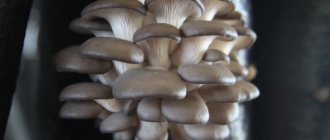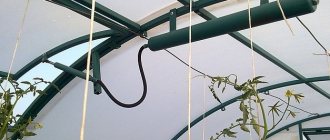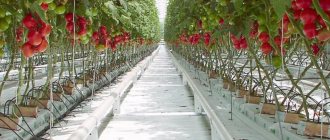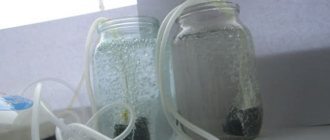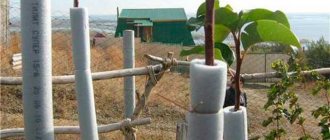- Country cottage area
How to tie up tomatoes in a greenhouse: 4 proven methods
Obviously, crops have different heat and humidity requirements. Therefore, when growing them together under one roof, it is necessary to select values that are acceptable to all. This will certainly affect the yield. It will be maximum only in conditions of growing a monoculture, when there is a separate shelter for each vegetable.
For accurate measurements, it is advisable to install a thermometer, or preferably several, in the greenhouse. They are placed at different heights at a distance from each other. This makes it possible to obtain objective indicators.
- Country cottage area
How to clean the inside of a polycarbonate greenhouse in the spring: 11 effective remedies
Why does the greenhouse need to be cooled in hot weather?
Any greenhouse, both glass and polycarbonate, accumulates heat according to the principle of a thermos. Transparent walls do not provide air circulation, and it warms up quickly. This is useful when the temperature outside is not yet high enough for plant growth and development. In addition, the heat remains at the same level throughout the night, which again has a beneficial effect on vegetable crops.
But in the summer it becomes much hotter, and the temperature inside the greenhouse also rises sharply. Once it reaches 32°C, the plants will start to have trouble. First, their flowers lose their ability to pollinate, then the green parts begin to wither and dry out. In addition, hot, stagnant air is an excellent breeding ground for diseases and pests. The harvest will be at risk.
Due to too high temperatures, plants in the greenhouse stop pollinating and may die
Fan blowing
The movement of air masses inside the greenhouse can slightly reduce the temperature inside the building. They create a forced air flow using a fan. For these purposes, a regular household model is suitable. The device is installed on the ground so that it is stable. The air stream is directed to the far end of the greenhouse. The fan head should be slightly tilted downwards.
The efficiency of greenhouse ventilation will increase. However, the method also has certain disadvantages. To operate the device you will need electricity, which means you will have to additionally buy an extension cord. Electricity bills will also increase, but not exorbitantly, especially since the fan operating time can be adjusted at will, and the heat rarely lasts for months at a time.
Methods for cooling a greenhouse
So, we are faced with the task: to give the plants warmth, and not dry heat, which will destroy them. There are several different ways to cool a greenhouse for this purpose.
Ventilation of greenhouses
Most often we leave the greenhouse door wide open. Unfortunately, this may not help: on hot summer days there is practically no air movement. Therefore, it is advisable to make transoms. For example, in a glass greenhouse, you can immediately insert opening frames into the walls or roof during construction.
Transoms in polycarbonate will have to be cut out. It is recommended to install vents near the ridge of the roof. It is important to take into account that the total area of the transoms should be approximately 1/6 of the area of the entire floor.
- Cut 2-3 rectangles on each side of the greenhouse slightly below the ridge. If possible, you can make the vents in a continuous row. Cover the cuts at the edges with adhesive tape - this will protect the polycarbonate from water flowing in during rains when the transoms are closed.
- Carefully attach the cut out parts to the top cut with door hinges. Install metal strips for fixation. You need to open and close manually.
- You can also install an automatic device for opening and closing the windows. It is controlled by a switch connected to a temperature sensor.
Make opening windows in the greenhouse to provide ventilation.
You can also provide the greenhouse with artificial ventilation, which will help avoid drafts. To do this, use special low-speed fans. They move large volumes of air slowly throughout the greenhouse, so they can be used with closed doors. And exhaust fans will also prevent condensation. Such a fan is placed on one of the end sides, while ventilation holes are made on the other side.
Special fans will not only ensure air movement in the greenhouse, but also eliminate condensation
If you cannot afford special fans or cannot install them, try using 2-3 household fans. For a small greenhouse this will be enough. Of course, this option is not economical, but running the fans for a few hours a day will help the plants.
Hydration
Many summer residents water paths in greenhouses generously. The water evaporates during the day, which provides humidity and a slight decrease in temperature.
Note! This method is great for cucumber greenhouses. Tomatoes do not like high humidity, so this type of watering is suitable for them only if the greenhouse has good ventilation.
A fogging system can be installed. It will simultaneously increase humidity and cool the greenhouse. In this case, you need to mulch the soil under the plants with a layer of about 7 cm to prevent overheating of the roots.
Fogging the greenhouse with irrigation will increase humidity and reduce temperature
The easiest way to moisturize is to hang wide sheets of fabric soaked in cold water around the greenhouse. Or place large containers filled with water. By the way, in the evening it can be used to water plants in the open ground.
Water in barrels will cool the greenhouse during the day, and in the evening it can be used to water the garden.
Shading
Another effective and popular method is shading greenhouses. This can be achieved by spraying surfaces with white liquid compounds or using shading screens.
For the first method, dilute 200 g of chalk in 10 liters of water and spray the outside of the greenhouse with a spray gun or sprayer. The chalk will dry out, and when the heat subsides, you can easily get rid of it with a hose, or it will be washed away by rain.
Cover the outside of the greenhouse with a layer of chalk solution
You can find recommendations for using lime, PVA glue or water-based emulsion. I do not advise. The first and second products are very difficult to wash off, and the third is also expensive. For me, chalk is the best option.
The next method is to place roll-up screens on the outside or inside of the greenhouse. For example, a wire is stretched inside in several rows close to the walls and ceiling, and a film made of lutrasil or spunbond is hung on it and secured with clothespins. The air cushion between the surface and the film prevents overheating inside the greenhouse. Such a shelter can only be placed on the ceiling, without lowering it to the ground.
Any covering material from the inside can protect from sunlight
You can also stretch a dark film outside the greenhouse and secure it to the ground with stones or pegs.
It is even easier to cover the greenhouse from the outside
Protective screens made of plastic or wooden slats will also help to shade the greenhouse. They are also often used as curtains or blinds at home. They are easy to unfold and retract and last a long time.
Application of covering materials
Another method of escape from the heat in a greenhouse can be a cape on the roof made of Spunbond or Lutrasil covering materials, in the absence of which you can use ordinary white sheets. You can achieve a temperature reduction of 10 - 13 degrees. The material is fastened in any available way.
The popular bookmaker has launched a mobile application for Android, you can follow the link absolutely free and without registration.
What to do if the onions are lying in the garden and how to save the harvest?
Reviews from summer residents and gardeners
I have been shading my greenhouse this way for many years. Already in May, we cover the upper part with white non-woven material, first glue it with double-sided tape, and also secure it with one-sided tape on top, since strong steppe winds are very frequent here. The most important thing is to stretch the material evenly and glue it evenly. And what a burning sun in the south in summer! But everything grows and bears fruit beautifully.
Lyubov Ivanovna Peycheva
https://ogorod.mirtesen.ru/blog/43276850619/Kak-ohladit-teplitsu-letom
I “store” covering material in the greenhouse. In the spring, I additionally cover the plantings, and as the weather warms up, I carefully straighten it, attaching it from the inside along the sunny wall and along the roof. From the inside. It is simply attached with clothespins to the structure. Does not shade plants, cools the air due to the air gap. And the material is kept dry and clean. This type of operation will last for many years.
Julia
https://ogorod.mirtesen.ru/blog/43276850619/Kak-ohladit-teplitsu-letom
To improve conditions during hot periods use:
Curtaining.
Evaporative cooling inside the greenhouse (not recommended).
Roof irrigation.
By evaporating water, the crop itself (the number of leaves) cools itself and the air in the greenhouse.
Alexey Kurenin
https://greentalk.ru/topic/33/
I whitewashed the greenhouse, closed all the doors except the upper windows. The larger the volume of the greenhouse, and the higher it is, the better the microclimate. the plants shade themselves. We also get scorching heat in the summer. and water once a week - it’s better a little every day. But after lunch and before sunset, finish it a couple of hours. I do this, although I can’t get around to making mulch.
pol
https://fermer.ru/forum/zashchishchyonnyy-grunt-i-gidroponika-rastenievodstvo/214012
Artificial shelters
Often, to shade the space inside the greenhouse, summer residents also use various types of shelters, laying them on top, on the south or east side.
Spunbond, burlap, and old clothes can be used as shelters.
Trampled the mentor: what does Patlakh do, who was kicked out of the show “Dancing”
How to make a comfortable hammock for a cat using improvised materials: he will be delighted
Postures for heart health: how to sit correctly
Nowadays you can also purchase a special protective reflective mesh for greenhouses.
Optimal conditions for greenhouse cucumbers
Even before the first shoots appear, containers with crops are kept warm for several days - +25+28°C. When the first greenery breaks through to the surface, the cover is removed, and the crops are installed in a well-lit place where the temperature is kept between +20+22°C. If we talk about night indicators, then in the first 3-5 days after the emergence of cucumber shoots they should be +16+17°C to prevent unnecessary growth of the stem and stretching of seedlings, then they are kept within +19+20°C.
Sudden temperature changes should not be allowed. This, as well as a sharp cold snap in the greenhouse, can lead to disease, depression, plant death, or simply loss of yield.
Temperature for greenhouse tomatoes
The optimal indicators are +20+22°C if the day is bright and sunny, and +19+20°C if the day is cloudy. Night temperature – +16+17°C. This regime is suitable before the fruiting period of tomatoes begins. When it begins, the maximum temperature can reach +26+32°C, but if it is hotter, then even the highest quality flowering will be of little use. Under such conditions, many necessary processes, such as photosynthesis, slow down and pollen grains do not germinate.
During the flowering period, temperatures should not be allowed to drop below +14+16°C, as the tomato will stop blooming.
At a certain period of time, a greenhouse tomato can begin to grow rapidly, and this process must be stopped by stabilizing the temperature at +25+26°C. If you don’t do this, the bush can simply build up a vegetative mass, from which you definitely won’t get the expected harvest.
After the first fruits are removed from the bush, the temperature is lowered to +16+17°C to stabilize the growth of the fruits and their ripening.



